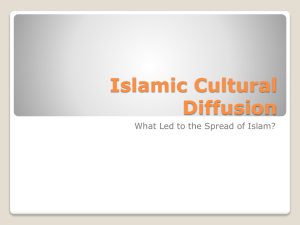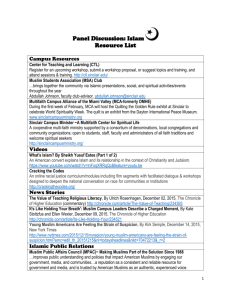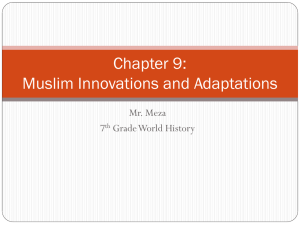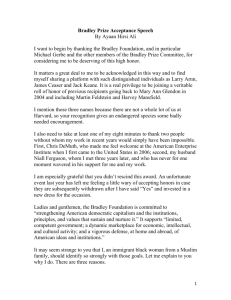Reading Packet: The Golden Age of Islam Name: Instructions: Read
advertisement
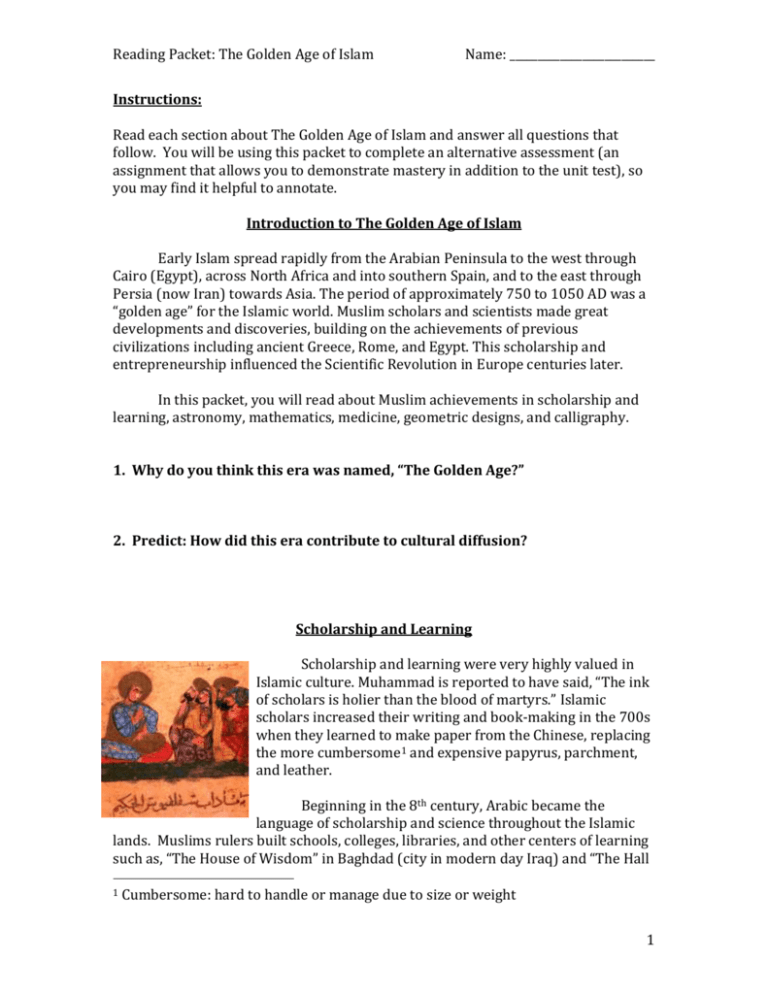
Reading Packet: The Golden Age of Islam Name: __________________________ Instructions: Read each section about The Golden Age of Islam and answer all questions that follow. You will be using this packet to complete an alternative assessment (an assignment that allows you to demonstrate mastery in addition to the unit test), so you may find it helpful to annotate. Introduction to The Golden Age of Islam Early Islam spread rapidly from the Arabian Peninsula to the west through Cairo (Egypt), across North Africa and into southern Spain, and to the east through Persia (now Iran) towards Asia. The period of approximately 750 to 1050 AD was a “golden age” for the Islamic world. Muslim scholars and scientists made great developments and discoveries, building on the achievements of previous civilizations including ancient Greece, Rome, and Egypt. This scholarship and entrepreneurship influenced the Scientific Revolution in Europe centuries later. In this packet, you will read about Muslim achievements in scholarship and learning, astronomy, mathematics, medicine, geometric designs, and calligraphy. 1. Why do you think this era was named, “The Golden Age?” 2. Predict: How did this era contribute to cultural diffusion? Scholarship and Learning Scholarship and learning were very highly valued in Islamic culture. Muhammad is reported to have said, “The ink of scholars is holier than the blood of martyrs.” Islamic scholars increased their writing and book-making in the 700s when they learned to make paper from the Chinese, replacing the more cumbersome1 and expensive papyrus, parchment, and leather. Beginning in the 8th century, Arabic became the language of scholarship and science throughout the Islamic lands. Muslims rulers built schools, colleges, libraries, and other centers of learning such as, “The House of Wisdom” in Baghdad (city in modern day Iraq) and “The Hall 1 Cumbersome: hard to handle or manage due to size or weight 1 Reading Packet: The Golden Age of Islam Name: __________________________ of Wisdom” in Cairo (city in modern day Egypt). Scholars at these education centers translated many important works from the ancient Greeks, Romans, and Egyptians. Among the texts studied were works by Plato and Aristotle, which influenced Muslim philosophers to use reason and logic to try to prove important truths. This scholarship helped to preserve important philosophical and scientific works from the ancient world and also to transmit this learning to schools in other regions such as Europe and Africa. Arabic Words That Entered the Western Vocabulary: AL-JABR = ALGEBRA AL-KEMIA = CHEMISTRY GHOL = GHOUL LAYMUN = LEMON NARANJ = ORANGE QAHWAH = COFFEE, CAFE QANAH = CANE QITAR = GUITAR SAFARA = SAFARI SUKKAR = SUGAR = ASUKAR (Spanish) TAFRIK = TRAFFIC ZIRAFAH = GIRAFFE Early Islamic teaching encourage the pursuit of all knowledge that helped to improve people’s lives Arabic became the international language of scholarship Muslims translated important works from ancient Greece and Egypt Huge libraries were established in big cities like Baghdad, Cairo and Damascus 3. Argue against the following statement: Early Muslim scholars were only interested in promoting Islamic works. Astronomy Muslims conducted much work in the field of astronomy, the study of objects in the universe. Astronomy had many practical uses for Muslims. For example, navigational tools were improved to locate the direction of Mecca. These 2 Reading Packet: The Golden Age of Islam Name: __________________________ instruments allowed worshippers far from the holy city to pray facing the right direction. Astronomers also figured out exact times for prayer and the length of the month of Ramadan. Beyond such practical matters, Muslim astronomers simply wanted to learn about the universe. Astronomers such as Al-Tusi and Al-Farghani, as distinguished astronomer of the House of Wisdom, wrote significant books on astronomy, which were later translated into Latin and influenced European astronomers such as Copernicus and Galileo. Some Muslim astronomers realized that Earth rotates, or turns, like a spinning top. Many questioned the accepted idea that Earth was the center or the universe. In fact, as later astronomers proved with measurements and evidence, Earth is not the center, but rather travels around the sun as the third planet from it. Astronomy was important to Muslims for practical reasons Astronomy contributed to navigation Observations of the sun and moon were used to determine prayer times and an accurate calendar 4. Why was it important to Muslims to have an accurate calendar? Mathematics Muslims greatly advanced the study of mathematics. They based their work in part on ideas from ancient Babylon (located on the Arabian Peninsula), India, and Greece. They adapted what they learned from the ancient texts and added their own contributions. One of these Muslim scholars was astronomer and mathematician alKhwarizmi (al- KWAR-iz-mee), who worked in the Hall of Wisdom in Cairo in the 800s. He is best known as “the father of algebra.” The word algebra comes form an Arabic word “al-jabr” which means “restoring balance.” Algebra is used to solve problems involving unknown numbers. An example is the equation 7X + 4 = 25. Using algebra, we can figure solve for X. The idea is to get x all by itself. First, subtract 4 from each side which gives 7X =21. Then divide each side by 7 which gives X = 3. 3 Reading Packet: The Golden Age of Islam Name: __________________________ Al-Khwarizmi’s book of algebra was translated into Latin and became the most important mathematics textbook used in the European universities during the High Middle Ages. Muslims also spread the Indian concept of zero. In fact, the word zero comes from an Arabic word meaning, “something empty.” Zeros also made it easier to write large numbers. For example, zero allows people to distinguish between 123 and 1,230. Islamic mathematicians built on the work of Greek, Indian, and Persian mathematicians Islamic mathematicians were interested in different number systems Developed algebra 5. Solve for X. 2X + 4 = 12 Medicine Muslims made some of their most important innovations in the field of medicine. Muslim doctors established the world’s first hospitals. By the 900s, most Islamic cities had one or two hospitals, many of which served as teaching centers for doctors in training. They gave patients remedies made from herbs and other plants, animals, and minerals. Pharmacists made hundreds of medications, some to dull pain, others to fight infection (called antiseptics), as well as ointments to heal wounds. For some problems, surgeons performed delicate operations as a last resort. Drugs, such as opium and hemlock, put patients to sleep before operations. Muslim surgeons removed limbs, took out tumors, and cleared cataracts (cloudy spots) from the eye. After surgery, doctors used thread made from animal intestine to stitch the wound. Ibn Sina, a Muslim doctor, wrote a medical book entitled, The Canon of Medicine, which explored the treatment of diseases. Europeans later translated this book and my other Muslims works into Latin. Medical schools used these texts to teach their students for centuries in both Europe and the Middle East. 4 Reading Packet: The Golden Age of Islam Name: __________________________ Muslim doctors established the world’s first hospitals Doctors treated patients with herbal remedies Muslims doctors performed surgery as a last resort Muslim medicine textbooks were used in European medical schools 6. Why do you think Muslim doctors chose surgery as a last resort? Geometric and Floral Design Muslims earned fame for their decorative arts. Early in the history of Islam, Muslims rejected the use of images of humans or animals in their visual art, especially religious art. Only God, they said, can create something that is alive. Instead, artists turned to shapes and patterns found in nature and geometry to create ornate designs and decorations. Artists applied these designs to plates, glassware, and decorative walls in mosques and palaces. A type of design called arabesque took its beauty from the natural world. In arabesque, artists crafted stems, leaves, flowers, and tendrils (threadlike parts of plants) into elegant patterns that were repeated over and over. Many designs used simple shapes such as circles, triangles, and squares that then became complex through repetition. Early Muslims refused to depict living things in their art Muslim artists used shapes found in nature to create ornate designs Arabesque designs used shapes found in nature and repeated them 7. Why did early Muslim artists refuse to depict humans or animals in their art? 5 Reading Packet: The Golden Age of Islam Name: __________________________ Calligraphy For Muslims, the highest form of decorative art was calligraphy, the art of beautiful writing. When Muslims began copying the Qur’an, they felt the only calligraphy was worthy to record the words of God. For this reason, they honored calligraphers above other artists. Calligraphers used sharpened reeds or bamboo dipped in ink to write on paper. Most forms of calligraphy featured round letters and cursive writing, in which the script flowed, and letters within words were connected. In addition to copying the Qur’an, artists used calligraphy to decorate everyday items. They put elegantly written lines of poetry on pottery, tiles, and swords. Bands of calligraphy trimmed the borders of fabric. Calligraphy even adorned coins, which often featured verses from the Qur’an. Highest form of decorative art was calligraphy Calligraphy was used to write the Qur’an Calligraphy decorated pottery, swords, and fabric borders 8. Why was calligraphy so highly valued in the Islamic culture? 6


